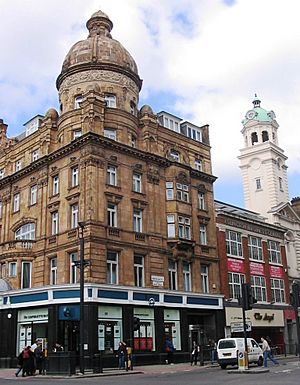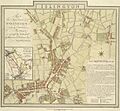Islington facts for kids
Quick facts for kids Islington |
|
|---|---|
 Buildings on Islington High Street |
|
| Area | 14.86 km2 (5.74 sq mi) (whole Borough) |
| Population | 206,125 (2011 census) (whole borough) |
| • Density | 13,871/km2 (35,930/sq mi) |
| OS grid reference | TQ315844 |
| London borough | |
| Ceremonial county | Greater London |
| Region | |
| Country | England |
| Sovereign state | United Kingdom |
| Post town | LONDON |
| Postcode district | N1,EC1 |
| Dialling code | 020 |
| Police | Metropolitan |
| Fire | London |
| Ambulance | London |
| EU Parliament | London |
| UK Parliament |
|
| London Assembly |
|
Islington (pronounced IZ-ling-tən) is a lively area in the north of Greater London, England. It's a key part of the London Borough of Islington. This district is mostly residential, meaning many people live here. It stretches from Islington's main street, known as High Street, all the way to Highbury Fields. The area includes busy streets like Upper Street, Essex Road, and Southgate Road.
Contents
- History of Islington: A Journey Through Time
- The Great North Road: Islington's Main Artery
- Business and Jobs in Islington
- Islington in Books, Music, and Film
- Sports in Islington
- Getting Around: Transport in Islington
- Learning in Islington: Education
- Important Buildings: Listed Structures
- Images for kids
History of Islington: A Journey Through Time
Islington has a long and interesting history, from its ancient beginnings to becoming a modern part of London.
What's in a Name? The Meaning of Islington
The name Islington comes from a very old language. Around the year 1005, the Saxons called this area Giseldone. Later, in 1062, it was known as Gislandune. This name means "Gīsla's hill." Gīsla was an Old English personal name, and dun meant "hill" or "down." Over time, the name changed to Isledon, which was used until the 1600s. Eventually, it became the "Islington" we know today.
How Islington Began: Early Days
Some roads in Islington, like Essex Road, were called "streets" even in medieval times. This might mean they were built by the Romans, but there isn't much proof left. We do know that the Great North Road became important in the 1300s. It connected to a new toll road that went up Highgate Hill. This road followed the path of what is now Upper Street. A toll gate at The Angel marked the edge of the village.
The Back Road, now Liverpool Road, was mainly used by people driving cattle. Animals would rest here before their final trip to Smithfield Market. Special pens and sheds were built along this road for the animals.
The first church in Islington, St Mary's, was built in the 1100s. It was replaced in the 1400s. Islington was owned by important church leaders, like the Bishop of London. There were also large, moated manor houses in areas like Canonbury and Highbury. By 1548, about 440 people lived here. Its rural feel and easy access to London made it a popular place for wealthy people to live.
Fun and Food: Gardens and Entertainment
In the 1600s and 1700s, Islington was a great place to grow vegetables for London. It also became a popular spot for Londoners to visit. They enjoyed the countryside feel. Many public houses (pubs) were built to serve both visitors and travelers. By 1716, Upper Street had 56 pubs. They offered fun activities like pleasure gardens, tea gardens, archery, and bowling.
By the 1700s, you could find music, dancing, billiards, fireworks, and even hot-air balloon rides. The King's Head Tavern has been in the same spot since 1543. Today, it's a Victorian building with a theatre.
In the 1800s, many music halls and theatres opened around Islington Green. One famous place was Collins's Music Hall. Parts of it are now a bookshop. The rest has become a new theatre. Many famous performers started their careers there, including Marie Lloyd and George Formby.
The Islington Literary and Scientific Society started in 1833. It aimed to share knowledge through talks and experiments. A special building was built for it in 1837. It had a library, reading room, museum, and a lecture hall. Later, this building became the successful Almeida Theatre.
The Royal Agricultural Hall: A Giant Building
The Royal Agricultural Hall was built in 1862 on Liverpool Road. It was a huge building, 75 feet high, with a glass roof that stretched 125 feet wide. It was built for the annual Smithfield Show, a big farming event. But it was also used for many other things, like concerts and the Royal Tournament. It was London's main exhibition site until the 1900s. It was the largest building of its kind, holding up to 50,000 people. During World War II, it was used by the post office. It never reopened as an exhibition hall. Today, the main hall is part of the Business Design Centre.
Islington's Homes: From Countryside to City Living
Islington grew a lot in the 1800s, with new houses covering the whole area. In 1801, about 10,000 people lived here. By 1891, this number jumped to over 319,000! This fast growth happened partly because horse-drawn buses started in 1830. Large, well-built houses attracted clerks, craftspeople, and professionals.
However, in the mid-1800s, many poor people moved to Islington. They were forced out of inner London as new railway stations were built. Many families shared houses in Islington. This, along with new railways reaching outer areas, made Islington less appealing to wealthier people. The area became less popular and fell into decline. By the mid-1900s, it was known for being run-down.
During World War II, bombs damaged many homes in Islington. After the war, many new council housing blocks were built. This was especially true in the 1960s. The worst old houses were cleared away. Islington remained a very crowded place.
From the 1960s, middle-class families started to rediscover the beautiful Georgian houses. Many homes were fixed up, and the area became fashionable again. This process, where an area becomes more expensive and attracts wealthier residents, is called gentrification.
Islington is still a diverse area today. It has private homes and apartments, but also social housing nearby. It is the most densely populated borough in the UK. In 2011, it had about 138.7 people per hectare, much higher than London's average of 52.0.
The Great North Road: Islington's Main Artery
Islington started to become a town along the Great North Road. This road is now known as the A1. As it goes through Islington, it changes names to Islington High Street, Upper Street, Holloway Road, and Archway Road. In 1716, the Great North Road was managed by the Islington Turnpike Trust. This trust grew quickly and built many major roads through the growing residential areas. These included Caledonian Road, Euston Road, City Road, and New North Road.
Islington High Street: A Historic Path
Islington High Street is about 500 meters long. It runs from Pentonville Road and City Road at one end to Islington Green at the other. There, it splits into Upper Street and Essex Road. The High Street first appeared on a map in 1590. At that time, it had nine inns (like the famous Angel), houses, and a public pond.
The Peacock Inn at 11 Islington High Street dates back to 1564. Its current front was built in 1857. It was mentioned in the book Tom Brown's Schooldays. The inn closed in 1962, but the building is still there.
Angel tube station on Islington High Street has the longest escalator on the London Underground system. It has 318 steps!
Upper Street: Shopping and Community
Upper Street is Islington's main shopping street. The local church, St Mary's, is also located on Upper Street.
Business and Jobs in Islington
The Angel business improvement district (BID) is an area around the Angel tube station. It includes parts of southern Islington and nearby Clerkenwell. This area focuses on improving local businesses and the community.
Islington in Books, Music, and Film
Islington appears a lot in modern English stories and culture.
Islington in Books
- Many novels by Charles Dickens feature Islington. For example, in Oliver Twist, parts of the story happen in Islington.
- In The Way We Live Now by Anthony Trollope, a character lives in Islington.
- The Diary of a Nobody by George and Weedon Grossmith has its main character living off Holloway Road.
- Douglas Adams, who wrote The Hitchhiker's Guide to the Galaxy, lived in Islington. He even named a character, Hotblack Desiato, after a local estate agent. Islington is also where Arthur Dent meets Trillian in the book.
- Martha Grimes's detective, Richard Jury, lives in a flat in Islington.
- In Neil Gaiman's Neverwhere, Islington is a fallen angel named after the Angel tube station.
- Nick Hornby's novels About a Boy and Slam are set in Islington.
- In the Harry Potter series by JK Rowling, the Order of the Phoenix has its secret headquarters at Number 12 Grimmauld Place, a made-up street in Islington.
- The Gaspard the Fox children's books are set in Islington. They show local places like the Islington Green War Memorial and the Regent's Canal.
Islington in Music
- In the comic opera The Zoo (1875), two characters are the Duke and Duchess of Islington.
- In 2008, the band Sparks played many concerts at the O2 Academy Islington. They released a funny song called "Islington N1" about the area.
Islington in Film
- In the 1979 film Scum, a character named Donald Woods lives on Almeida Street in Islington.
Sports in Islington
Islington offers over 60 different sports and activities. You can find them at more than a hundred clubs, leisure centres, parks, and other places. The Islington Boxing Club started in 1974.
The area is also home to top-flight professional football club Arsenal. Their large stadium is in Holloway.
Getting Around: Transport in Islington
Islington is well-connected by many bus routes. There's a big bus interchange near the Angel tube station. Special parking rules apply throughout the area.
Nearby Places to Explore |
Nearby Train and Tube Stations
|
Learning in Islington: Education
Islington has many schools. According to the latest numbers, there are 47 primary schools and 10 state-funded secondary schools in the area.
Important Buildings: Listed Structures
Islington has many historic buildings that are "listed," meaning they are protected because of their special importance.
Grade II* Listed Buildings: These are particularly important buildings.
- The Union Chapel
- 3 Terrett's Place (an 18th-century house)
- St Paul's Church, St Paul's Road (designed by Sir Charles Barry, who also designed the Houses of Parliament)
- Canonbury Tower
Selected Grade II Listed Buildings: These are important buildings that need to be protected. Islington has many Georgian houses, shops, and pubs. Whole rows of buildings are listed, including parts of Liverpool Road and Islington High Street/Upper Street. Other streets with many listed buildings include Arlington Square, Camden Passage, Compton Terrace, and Essex Road.
Other Grade II listed structures include:
- The Almeida Theatre
- The Angel building (a former public house and hotel)
- The Business Design Centre (which includes the old Royal Agricultural Hall)
- The Camden Head public house
- The Hope and Anchor public house
- Ironmonger Row Baths
- Islington Town Hall
- M Manze's Pie and Eel Shop
- The Old Queen's Head public house
- Resurrection Manifestations GracePoint church (originally the Carlton Cinema, Essex Road)
- St John's Church
- St Mary's Church (rebuilt after World War II)
- South Library
- The York public house
- Emirates Stadium
- London Art House
Images for kids
-
The Egyptianate former Carlton Cinema, Essex Road is Grade II listed.










